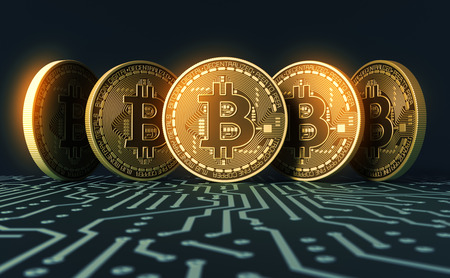Bitcoin: The Future Of Currency?

80633957 – five virtual coins bitcoins on blue printed circuit board
February 28, 2018
The invention of the internet has opened the door to seemingly limitless potential and possibilities for humankind. One of these possibilities is a decentralized banking system, as seen by the rise of cryptocurrencies, a system of “digital assets” not controlled by governments or banks. The first and best known cryptocurrency is Bitcoin.
But what exactly is Bitcoin?
It all began back in 2009 when the internet-born phenomena called Bitcoin was created by a person, or group of people, under the name Satoshi Nakamoto; it was released as open-source software to combat the financial crisis.
The way Bitcoin functions, which is through a complicated system called the blockchain, allows it to work without a central bank or single administrator. This means that Bitcoin is not regulated by any government, preventing transaction fees from being charged.
The currency can be obtained through a process called “mining,” though it isn’t what one might expect. Mining is when an individual assists the network with tracking and recording Bitcoin transactions on a digital ledger. There is a small chance that when helping with the transaction, one will be rewarded with a small percentage of a Bitcoin for the effort.
Unfortunately, this mining process is incredibly inefficient due to the amount of energy it requires: Bitcoin mining eats up approximately 20,000 gigawatt hours of electricity per year, according to Forbes, which is close to the total amount of energy used by Ireland.
But why does it consume so much energy?
One of the the most important components is “blockchain,” a ledger that records any and every instance of anyone buying or selling anything related to Bitcoin. This data is updated and copied hundreds of thousands of times across a massive number of computers every hour.
The blockchain system is regarded as “incorruptible”; it is impossible to fraud or cheat the system because of “keys.” Keys are blocks of information that are used to make a mathematical guarantee that the messages recorded in the ledger are 100 percent legitimate.
The next component of Bitcoin is a “coinwallet,” which can be obtained through downloading an app, such as Coinbase, or going to a website and creating an account that will store your Bitcoins.
Bitcoin has been around for roughly eight years, and since its release, it has gained massive popularity. It is so popular, in fact, that the price of a single coin has gone from hundreds of dollars to tens of thousands of dollars.
However, due to the way Bitcoin functions, the price fluctuates, meaning that it is never at a fixed price for long. Today it may be worth $18,000, but tomorrow the price could drop to $2,000 or rise to $30,000, for example. This makes Bitcoin an unreliable source of income. Despite this, Bitcoin investment skyrocketed from $98 million in 2013 to $335 million in 2014.
So what does Bitcoin mean for the future of banking and money transactions?
Mr. Smith, the computer science teacher at SFHS, is familiar with Bitcoin and believes it is incredibly inefficient due to the absurd amount of energy it requires. But he stated this is just one of the problems plaguing the cryptocurrency, another one being its instability. “I think it is asinine and going to crash, so really they should just shut it down,” he said.
Mr. Smith’s strong opinion lines up with the recent enormous crash Bitcoin endured about a month ago when the price dropped by almost $20,000.
Mr. Smith believes that “We’re almost at the point of primarily using digital money, but we still aren’t completely rid of physical currency, and we may never see it totally disappear.” He said though it is true that society uses digital platforms to move money, the possibility of a cryptocurrency becoming the primary form of currency is highly unlikely.

